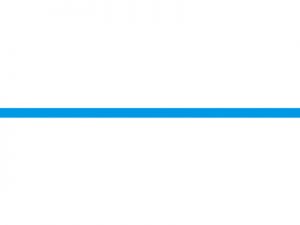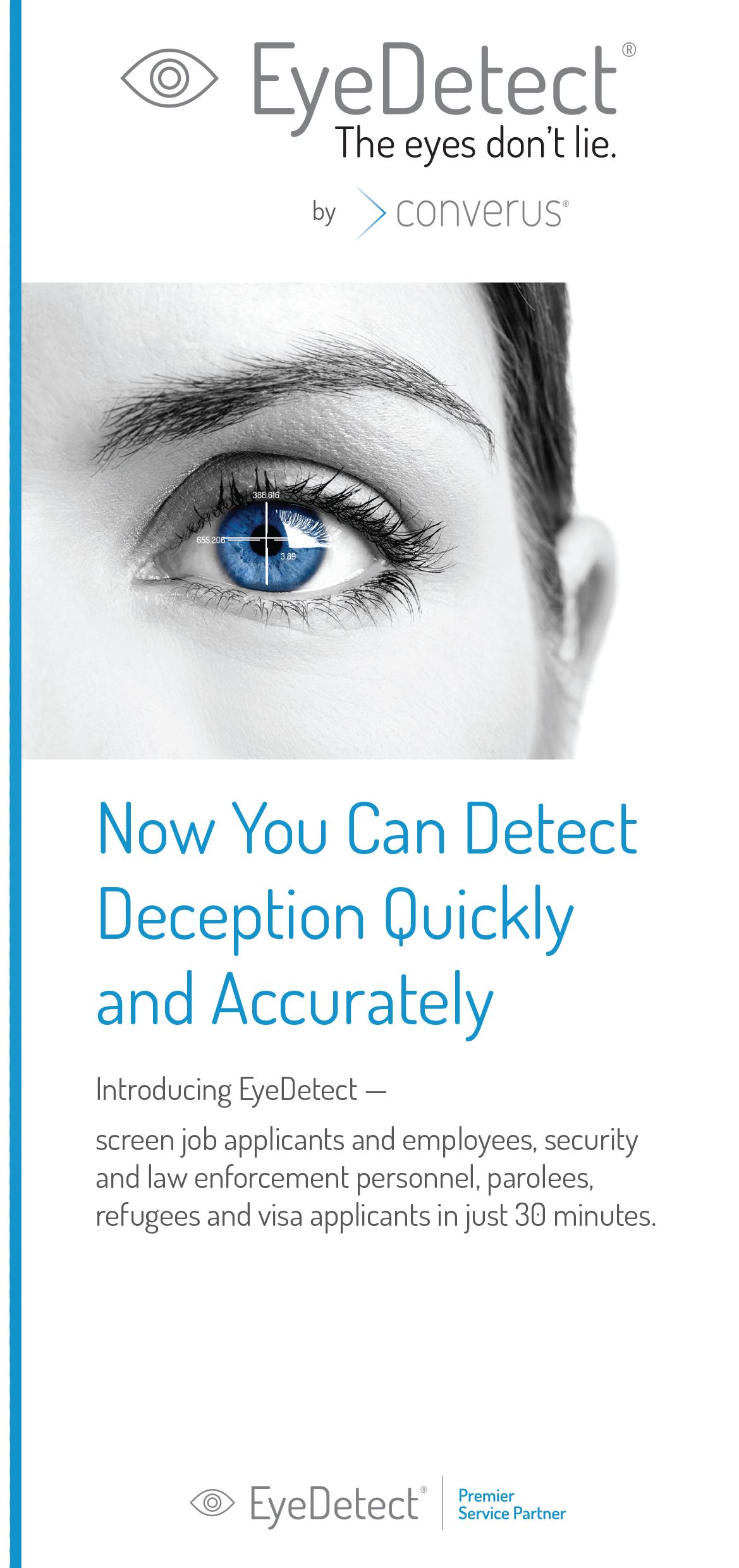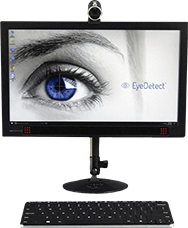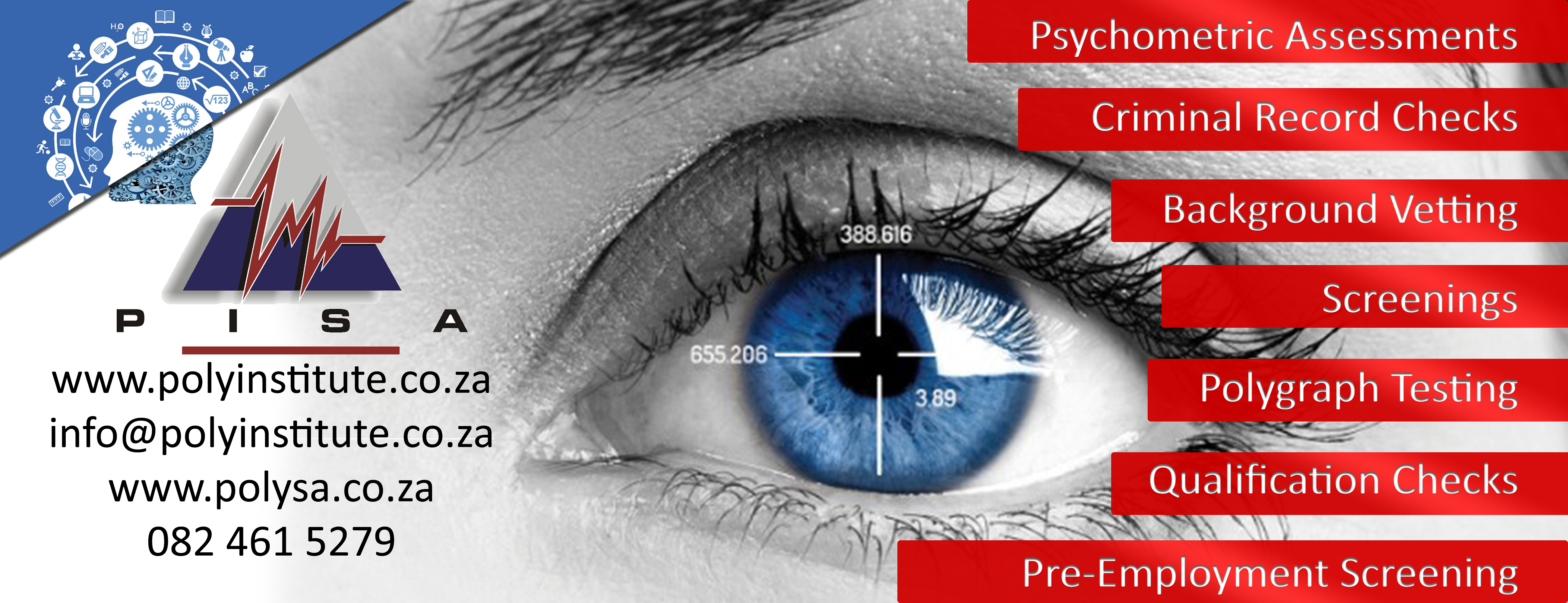Converus EyeDetect Detection of Deception Instrument
The future of lie detection technology has arrived in South Africa. The Converus EyeDetect is an incredible Detection of Deception instrument. The Converus EyeDetect system is the latest scientific advancement to answer the problem of large scale screenings of all kinds. It is more cost effective than polygraph examinations, are quicker to implement and allows for large scale screenings in shorter spans of time. Despite all of these advantages it still boasts an accuracy rating of 86%.
NON-INTRUSIVE
There are no sensors attached to the participant as the instrument only measures certain physiological changes that occur within the eye. The process is mostly automated and all the questions on the test are answered privately by the participant with simple 'Yes' or 'No' statements.
SIMPLE TO USE
The Converus EyeDetect system is easy to set up, simple to implement and simple to complete. Due to the process being automated the participants only need to follow a few onscreen instructions, and are given a practice test to get used to the process.
COST EFFECTIVE
The test is cheaper to implement than standard polygraph testing and has less limitations, which is perfect for large scale screenings or pre-employment programs. Alternatively, your company can purchase an instrument, which will include training and support from the PISA Integrity Assessment Centre, which significantly reduces the implementation cost as only a license fee is required.
ACCURATE
The Converus EyeDetect system has a scientifically validate accuracy of 86%, making it one of the most accurate detection of deception technologies in the world. If EyeDetect and polygraph are used in succession, they combine statistically for an outcome confidence as high as 98.9% when an examinee passes or fails both tests. To see how, read the AAPP Journal article here: Police Polygraph Journal.

“The polygraph is ideal for crime-specific incidents. But because of cost, invasiveness, training and upkeep, it can’t be used on a large scale. With EyeDetect, those costs can be reduced significantly. It’s non-invasive, quick, and results are immediate. It helps companies hire and keep honest people.”
–Former program manager at the U.S. Dept. of State



How Does EyeDetect Work?
The brain and eyes respond to deception. The greater the consequences of the lie, the greater the cognitive load. This affects the eyes. EyeDetect measures changes in pupil diameter, eye movement, reading behavior, blinks, fixations and other things.
Using an infrared camera and complex algorithm, a person’s credibility score is calculated: truthful or deceptive.
Participants answer True/False questions on a computer. The infrared camera records eye behaviors.
When the test concludes, responses to questions and eye measurements are uploaded to a web server for immediate scoring.
Those authorized can view results in the web-based Converus Dashboard. A Converus Credibility Score shows the probability the person was truthful.
What Does EyeDetect Measure to Determine Deception?
While reading a computer-based series of questions, EyeDetect measures an examinee’s response accuracy, response time, pupil diameter, reading behavior and blink rates. The results are consistent with the cognitive workload hypothesis.
Observations include:
- Guilty individuals — when compared to innocent individuals and while responding to simple test statements — make more errors, take longer to respond, make more fixations on the text, have longer reading times, and have longer rereading times.
- Guilty individuals blink significantly less often as they process statements answered deceptively versus answered truthfully.
- Guilty participants show greater increases in pupil diameter for statements answered deceptively than for statements answered truthfully.
- Guilty participants respond faster, make fewer fixations, and spend less time reading and reading statements about the crime they committed than statements about another crime or neutral statements.
Simply put, an increase in the cognitive load is associated with recalling a task and used to distinguish between deceptive and non-¬deceptive responses. This is more pronounced when deceptive individuals respond to complex statements. It takes motivation and effort to deceive.
Corporate & Enterprise Lie Detection: Create a Culture of Integrity
International studies indicated that corruption adds up to 10% to the cost of doing business and up to 25% to the cost of procurement contracts in developing countries. Considering the high crime-rate in South Africa, it the impact of such unethical and illegal activities are far worse, and the implications can be devastating to the company, the customer and the employee. This is why integrity management should be such a high priority in any business.
For human resources managers and leaders, the Converus EyeDetect system is the ideal tool for large scale integrity management programs, and with the assistance of the PISA Integrity Assessment Centre can be implemented easily, effectively and without breaking the budget. Never before has it been so simple to instill a culture of integrity in the workplace.
For security companies the Converus EyeDetect system is the ultimate means of ensuring that security officers do not become compromised. Due to the low cost of implementation the system can be used for continuous nationwide screening. With the assistance of the PISA Integrity Assessment Centre your security company can deploy their own EyeDetect instruments nationwide with their own trained employees. Due to the test itself being an automated process, it means that the results can not be tampered with or influenced with personal bias or threats, making the ultimate in uncompromising integrity management solutions.
Scientific Studies Validates EyeDetect
In 2006, after the Converus Science Team completed substantial testing of this concept of monitoring eye behavior to detect deception, a University of Utah psychology graduate student working with the science team published its findings. The Osher Dissertation documented the first lab study that demonstrated the effectiveness of an ocular-motor deception test (ODT). A second formal scientific study in 2008 confirmed the effectiveness of the ODT technology, and its results were published in the Webb Dissertation in August of that year. In 2012, field studies were conducted. The results were peer reviewed by other scientists and professors and published on April 30 of that year in the Journal of Experimental Psychology: Applied. Since the initial product launch, the Science Team has continued to carry out field studies in various languages. Results will be published in an ongoing manner.
How Can We Help You?
Do not hesitate to contact the PISA Integrity Assessment Centre and let our years of experience work for you. Whether you would like to make a booking, ask for a consultation or would like more information on how our multitude of products and service can benefit your business, we are ready and eager to assist in any way we can.
Would you like to contact us for a booking or consultation?
Would you like to know more about our products and services?
Would you like to know more about the company?
Would you like to know more about polygraph examinations and the law in South Africa?
Download the PISA Integrity Assessment Centre A4 advert: Download
Download the PISA Integrity Assessment Centre small advert: Download
Download the PISA Integrity Assessment Centre Tri-Fold Flyer: Download

For more information specifically related to polygraph examinations, please visit The Polygraph Institute of South Africa.
For more information specifically related to pre-employment screenings, please visit the Pre-Employment Screening Centre.
For more information specifically related to our psychometric assessments, please visit the PISA Psychometric Assessment Centre.
You must be logged in to post a comment.